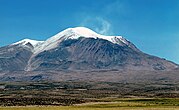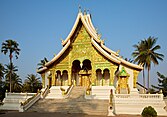Main Page
From today's featured article
Guallatiri is a stratovolcano in Chile that is 6,060–6,071 m (19,880–19,918 ft) high. It is located southwest of, or possibly within, the Nevados de Quimsachata volcanic group. The summit, surrounded by numerous fumaroles, may be a lava dome or volcanic plug, while the lower flanks of the volcano are covered by lava flows and lava domes. The volcano's eruptions have produced mostly dacite along with andesite and rhyolite. Past glaciation has left moraines on Guallatiri. A large eruption took place approximately 2,600 years ago. Guallatiri has been active since prehistoric times, with the latest known eruption in 1960. Fumarolic and seismic activity is ongoing and has resulted in the deposition of sulfur and other minerals on the volcano. It is covered by an ice cap above 5,500–5,800 m (18,000–19,000 ft) elevation that has retreated and broken up into separate ice bodies. Part of Lauca National Park, Guallatiri is monitored by the Chilean National Geology and Mining Service. (Full article...)
Did you know ...
- ... that there is an East Quoddy Head Lighthouse (pictured) and a West Quoddy Head Lighthouse on opposite sides of a bay, but one is in Canada and the other is in the United States?
- ... that Dahiru Musdapher, the 12th chief justice of Nigeria, was once a BBC World Service contributor for West Africa and Hausa?
- ... that To Catch a Copper hoped to show "an enjoyable journey of officers solving cases", but discovered "a misconduct process that was unfit for purpose in addressing seriously concerning behaviour"?
- ... that in 1848 Karl Schädler performed the first surgery with chloroform anaesthesia in Liechtenstein?
- ... that the planned sale of a Texas TV station was the subject of a lawsuit more than seven years after it closed for the last time?
- ... that Bob Born became known as the "Father of Peeps" for automating the production of an Easter marshmallow treat?
- ... that food critic Grace Dent reviewed a Liverpool restaurant that served her rice pudding flavoured with a substance that is banned in the United States for its lethality?
- ... that it took four games for Todd Leslie to set the NCAA Division I record of fifteen consecutive three-point shots made?
- ... that Young Dirty Bastard rapped despite Ol' Dirty Bastard telling him not to?
In the news
- Flooding (pictured) in the Arab Gulf states leaves at least twenty-four people dead.
- The historic Børsen in Copenhagen, Denmark, catches fire.
- A knife attack in Sydney, Australia, leaves seven people dead.
- In retaliation for an Israeli airstrike on the Iranian consulate in Damascus, Iran conducts missile and drone strikes against Israel.
- In the South Korean legislative election, the Democratic Party–led opposition alliance increases its majority in parliament.
On this day
April 19: Feast day of Saint Alphege of Canterbury (Catholicism, Anglicanism), Education and Sharing Day in the United States (2024), Primrose Day in London
- 1773 – The Polish Partition Sejm met to discuss the First Partition of Poland, carried out the previous year by Russia, Prussia and Austria.
- 1809 – War of the Fifth Coalition: French general Louis-Nicolas Davout defeated an Austrian force in Lower Bavaria, allowing him to rejoin the main French army.
- 1927 – American actress Mae West (pictured) was sentenced to ten days in jail for "corrupting the morals of youth" with her play Sex.
- 1989 – A gun turret exploded on board the United States Navy battleship Iowa, killing 47 sailors.
- Uesugi Kenshin (d. 1578)
- Elizabeth Dilling (b. 1894)
- Denis O'Brien (b. 1958)
From today's featured list
Laos has three sites on the list of World Heritage Sites. The United Nations Educational, Scientific and Cultural Organization (UNESCO) designates World Heritage Sites of outstanding universal value to cultural or natural heritage that have been nominated by countries that are signatories to the UNESCO World Heritage Convention, established in 1972. Laos, officially the Lao People's Democratic Republic, ratified the convention on 20 March 1987. The town of Luang Prabang (pictured) was listed in 1995, Vat Phou in 2001, and the Plain of Jars in 2019. All three sites are cultural. In addition, Laos has two sites on UNESCO's tentative list. (Full list...)
Today's featured picture

|
Picea omorika, commonly known as the Pančić spruce or the Serbian spruce, is a species of coniferous tree endemic to the valley of the Drina in western Serbia, and eastern Bosnia and Herzegovina, with a total range of only about 60 hectares (150 acres) at altitudes of 800 to 1,600 metres (2,625 to 5,249 ft). The species was originally discovered near the Serbian village of Zaovine on Mount Tara in 1875, and named by the Serbian botanist Josif Pančić. It is a medium-sized evergreen tree that generally grows to a height of around 20 metres (66 ft), with a trunk diameter of up to 1 metre (3 ft). It has buff-brown shoots with dense hair coverage and needle-like leaves. Its cones are fusiform in shape and grow to a length of 4 to 7 centimetres (2 to 3 in). They are dark purple when young, maturing to dark brown, and have stiff scales. This young female P. omorika cone, with a length of 22 millimetres (0.87 in), was photographed near Keila, Estonia. Photograph credit: Ivar Leidus
Recently featured:
|
Other areas of Wikipedia
- Community portal – The central hub for editors, with resources, links, tasks, and announcements.
- Village pump – Forum for discussions about Wikipedia itself, including policies and technical issues.
- Site news – Sources of news about Wikipedia and the broader Wikimedia movement.
- Teahouse – Ask basic questions about using or editing Wikipedia.
- Help desk – Ask questions about using or editing Wikipedia.
- Reference desk – Ask research questions about encyclopedic topics.
- Content portals – A unique way to navigate the encyclopedia.
Wikipedia's sister projects
Wikipedia is written by volunteer editors and hosted by the Wikimedia Foundation, a non-profit organization that also hosts a range of other volunteer projects:
-
Commons
Free media repository -
MediaWiki
Wiki software development -
Meta-Wiki
Wikimedia project coordination -
Wikibooks
Free textbooks and manuals -
Wikidata
Free knowledge base -
Wikinews
Free-content news -
Wikiquote
Collection of quotations -
Wikisource
Free-content library -
Wikispecies
Directory of species -
Wikiversity
Free learning tools -
Wikivoyage
Free travel guide -
Wiktionary
Dictionary and thesaurus
Wikipedia languages
This Wikipedia is written in English. Many other Wikipedias are available; some of the largest are listed below.
-
1,000,000+ articles
-
250,000+ articles
-
50,000+ articles





